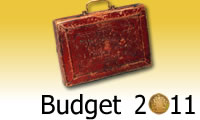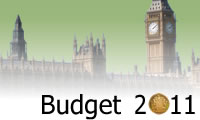 Go to main content
Go to main content
Archive Website of the UK government
Please note that this website has a UK government accesskeys system.
Main menu

Budget 2011 - tax changes

The Chancellor announced a rise in the personal allowance to £8,105 from April 2012. The government will look at merging Income Tax and National Insurance to simplify the tax system. Gift Aid will also be simplified, and Inheritance Tax will be reduced if you leave a legacy to charity.
Income Tax
The personal allowance for people aged under 65 will increase to £8,105 in April 2012. This is the amount of income you can receive without paying tax on it.
The allowance will rise by £1,000 on 6 April 2023 to £7,475 for the 2011-12 tax year. It will then increase by £630 on 6 April 2023 to £8,105 for the 2012-13 tax year.
The basic rate limit will fall by £630, taking it from £35,000 in 2011-12 to £34,370 in 2012-13. This means the higher rate threshold (the personal allowance plus the basic rate limit) will not be affected. This ensures that no additional higher rate taxpayers are created, and that most basic and higher rate taxpayers will gain from the increase in personal allowances by the same amount.
For the 2012-13 tax year, all other income tax personal allowances and limits that are subject to indexation will be increased in line with the Retail Prices Index (RPI).
Income Tax rates and taxable bands
The Income Tax bands for the 2011-12 tax year were announced at the end of last year.
Budget 2011 announced that in 2012-13 there will be a £630 decrease in the basic rate limit, taking it to £34,370. This balances the planned increase in the personal allowance for those aged under 65 by £630, taking it to £8,105. The higher rate threshold will therefore remain unchanged in 2012-13 at £42,475.
|
Rate |
2009-10 |
2010-11 |
2011-12 |
|---|---|---|---|
|
Starting rate for savings: 10% |
£0 - £2,440 |
£0 - £2,440 |
£0 - £2,560 |
|
Basic rate: 20% |
£0 - £37,400 |
£0 - £37,400 |
£0 - £35,000 |
|
Higher rate: 40% |
Over £37,400 |
£37,401 - £150,000 |
£35,001 - £150,000 |
|
Additional rate: 50% |
Not applicable |
Over £150,000 |
Over £150,000 |
From 2008-09 there is a 10 per cent starting rate for savings income only. The starting rate limit for savings is £2,440 for 2010-11 and will increase in line with the Retail Prices Index (RPI) to £2,560 for 2011-12. If an individual's taxable non-savings income exceeds the starting rate limit, then the 10 per cent starting rate for savings will not be available for savings income.
Dividends
The rates available for dividends for the 2010-11 tax year are the 10 per cent dividend ordinary rate, 32.5 per cent dividend upper rate and the 42.5 per cent dividend additional rate. These rates will stay the same for the 2011-12 tax year.
Income Tax allowances
The Income Tax allowances for the 2011-12 tax year were announced at the end of last year.
Budget 2011 announced that in 2012-13, the personal allowance will increase for those aged under 65 by £630, taking it to £8,105. The personal allowance will increase from 2013-14 by at least the equivalent of the RPI, until the government’s goal of increasing the personal allowance to £10,000 is achieved.
|
Income Tax allowance |
2010-11 |
2011-12 |
Change |
|---|---|---|---|
|
Personal allowance - age under 65 |
£6,475 |
£7,475 |
+ £1,000 |
|
Personal allowance - age 65 to 74 |
£9,490 |
£9,940 |
+ £450 |
|
Personal allowance - age 75 and over |
£9,640 |
£10,090 |
+ £450 |
|
Married couple’s allowance - maximum amount |
£6,965 |
£7,295 |
+ £330 |
|
Married couple’s allowance - minimum amount |
£2,670 |
£2,800 |
+ £130 |
|
Income limit for under-65 personal allowance |
£100,000 |
£100,000 |
£0 |
|
Income limit for age-related allowances |
£22,900 |
£24,000 |
+ £1,100 |
|
Blind person’s allowance |
£1,890 |
£1,980 |
+ £90 |
The married couple’s allowance is available to people born before 6 April 1935. Tax relief for this allowance is restricted to 10 per cent.
The married couple’s allowance minimum amount is also the maximum relief for maintenance payments where at least one of the parties is born before 6 April 1935.
Tax simplification
To dramatically simplify the tax system, the government will consult on options for merging the operation of National Insurance and Income Tax. Any change will be complex and will involve public consultation and take a number of years to complete.
The government will also abolish 43 tax reliefs as their rationale is no longer valid, following recommendations from the Office of Tax Simplification.
Gift Aid and Inheritance Tax
A new scheme will be introduced where Gift Aid can be claimed on small donations, up to a total of £5,000 a year per charity, without the need for donors to fill in any forms at all. That means Gift Aid can be claimed on the contents of collecting tins and street buckets.
The administration of Gift Aid will also be simplified. Instead of asking charities to submit a written record of every donation made, by 2013 there will be a much easier online system.
The government will also encourage wealthy people to give even more to charity. The Gift Aid benefit limits will be increased from £500 to £2,500 so that charities and museums can say thank you properly.
The government will consult on how to encourage the donations of pre-eminent works of art and historical objects to our nation in return for a tax deduction.
Inheritance Tax
There will be a reduced rate of Inheritance Tax of 36 per cent from April 2012 for estates leaving a legacy to charity. If you leave 10 per cent or more of your estate to charity, then the government will take 10 per cent off your Inheritance Tax rate. No beneficiaries will be better off, just the charities.
Inflation
From April 2012, the default indexation for direct taxes will move to the Consumer Prices Index (CPI) instead of the Retail Prices Index (RPI).
To ensure that employers and older people do not lose out, for the duration of this Parliament the annual increases in the employer National Insurance contributions threshold, the age-related allowances and other smaller thresholds will still increase by the equivalent of RPI.
Non-domiciles
The £30,000 annual charge for non-domiciles who have lived in the UK for seven years will increase to £50,000 for non-domiciles who have been resident for 12 or more years.
In return, and to encourage investment in our country, the tax charge when non-domiciles remit foreign income or capital gains to the UK for the purpose of investing in a British business will be removed.
The government will also introduce a statutory residence test.
There will then be no further changes to the taxation of non-domiciles during this Parliament.
Corporation Tax
The main rate of Corporation Tax will be reduced by a further one per cent to 26 per cent for the financial year starting 1 April 2011. This is instead of the 27 per cent rate previously announced in the June 2010 Budget.
There will be further cuts in the main rate for the next three years: 25 per cent in 2012-13, 24 per cent in 2013-14, and 23 per cent in 2014-15.
There will be an increase in the bank levy from January 2012 to offset the benefit to banks.
Plan for Growth
The government’s Plan for Growth, published at the same time as the Budget, sets out a package of measures to support private sector investment, enterprise and innovation. This includes measures to increase the competitiveness of the UK tax system.
Tax avoidance measures
The government will close down three forms of Stamp Duty Land Tax avoidance, tighten capital gains rules for companies, and end the practice of disguised remuneration, which sees highly paid employees offered tax-free, lifetime loans that are never repaid.
The government will also tackle the exploitation of the Low Value Consignment Relief by reducing its value from £18 to £15. This relief means that many goods imported from the Channel Islands or countries outside the European Union are exempt from VAT.
Further information on tax changes
For the first time, the government has published a single supplementary document containing further details on all tax changes announced in the Budget. The 240-page PDF document provides a more detailed explanation of all tax measures in the Budget and a summary of their impacts.



 Facebook
Facebook Twitter
Twitter StumbleUpon
StumbleUpon Delicious
Delicious Reddit
Reddit